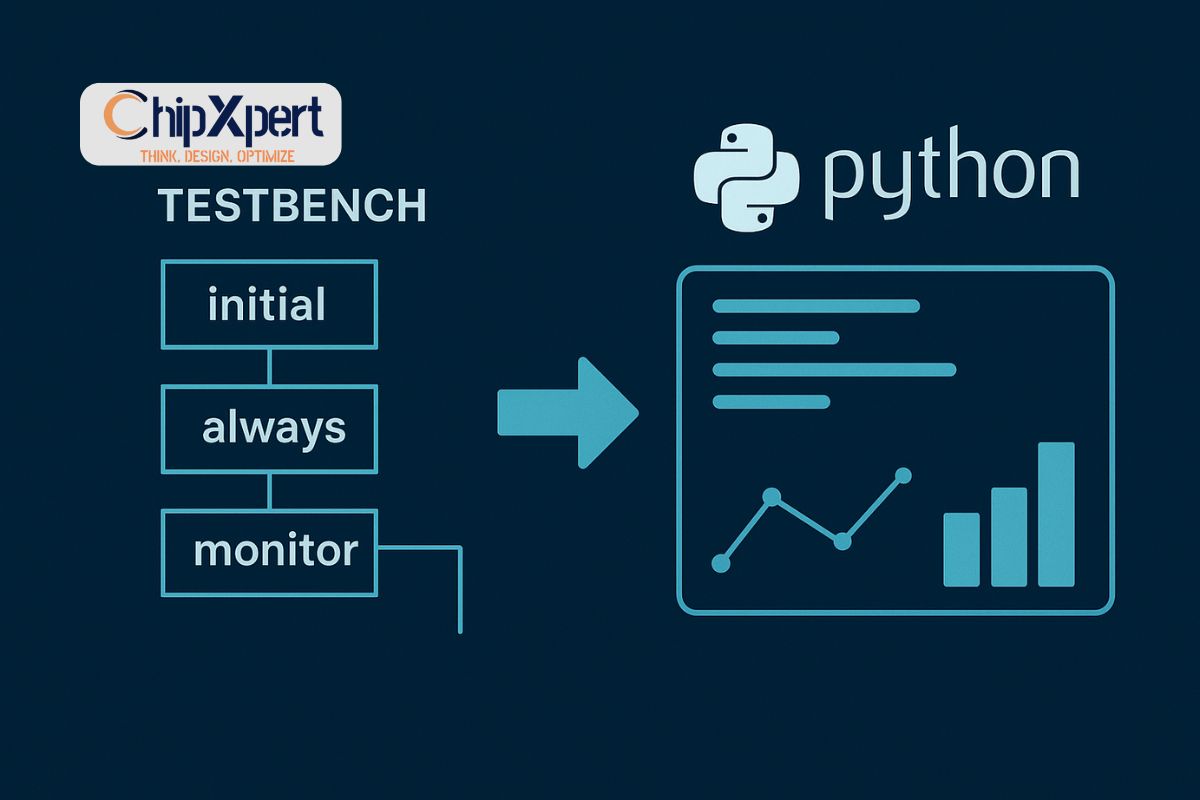Python in the Verification Lab: How It’s Changing the Game Beyond SystemVerilog
Walk into any modern verification lab, and you’ll hear the familiar hum of simulations running. For over a decade, the soundtrack to this work has been written in SystemVerilog and UVM. They are the undisputed champions for building structured, reusable testbenches and creating constrained-random stimuli.
But open another terminal on a verification engineer’s workstation, and you’re increasingly likely to see a different language: Python.
Python isn’t here to replace SystemVerilog; it’s here to empower it. At ChipXpert, Hyderabad’s premier VLSI training institute, we see Python not as a competitor, but as a critical force multiplier that every modern verification engineer needs in their toolkit. Let’s explore how Python is complementing and even replacing parts of the traditional verification flow.
The SystemVerilog Strength (And Its Limits)
First, let’s give credit where it’s due. SystemVerilog is incredibly powerful for what it was designed to do:
- Constrained-Random Stimulus Generation: Its built-in constraints solver is specialized and efficient for generating valid hardware stimuli.
- Building UVM Testbenches: Its object-oriented features and built-in parallelism are perfect for creating the complex, hierarchical structures of a UVM environment.
- Protocol-Specific Checking: Its cycle-accurate nature is essential for verifying low-level protocol timing.
However, SystemVerilog isn’t the best tool for everything. It can be verbose for simple tasks, it’s not great at data analysis, and its ecosystem for string manipulation, file handling, and connecting to external tools is limited.
Enter Python: The Versatile Glue
Python enters the verification scene not to rebuild the UVM testbench, but to handle everything around it. Its simplicity and vast ecosystem of libraries make it the perfect “glue” language.
1. Testbench Automation and Regression Management
This is Python’s sweet spot. A typical regression involves hundreds of tests, multiple seeds, and different configurations.
- SystemVerilog Alone: Managing this often involves clunky shell scripts or Makefiles.
- With Python: You can write a powerful, readable Python script to:
- Parse a YAML/JSON configuration file for test parameters.
- Dynamically generate simulation commands and launch jobs in parallel on a compute farm.
- Parse log files to extract key metrics like pass/fail status, coverage numbers, and simulation time.
- Generate a detailed HTML regression report with graphs and trends overnight.
This transforms regression from a manual, error-prone process into a fully automated, data-driven pipeline.
2. Data Science for Verification Analysis
Verification generates a mountain of data. Python, with libraries like Pandas, NumPy, and Matplotlib, is built to analyze it.
- Coverage Analysis: Instead of just looking at a coverage percentage, you can use Python to read a UCIS database, analyze coverage holes, and correlate them with failing tests to identify critical missing scenarios.
- Result Trend Analytics: You can track coverage progress over time, visualize it, and use it to predict when you’ll hit your coverage goals—a practice known as Coverage Closure.
3. Building Intelligent Stimulus Generators
While SystemVerilog is great for low-level constraints, Python excels at high-level scenario generation.
- Complex, System-Level Scenarios: You can use Python to generate a sequence of high-level system events (e.g., “boot Linux,” “load this neural network,” “play a video stream”) and convert them into memory-mapped register writes that your SystemVerilog testbench can consume.
- Machine Learning for Verification: This is the cutting edge. Python’s ML libraries (like Scikit-learn) can be used to create adaptive test generators that learn from coverage results and focus on generating stimuli for untested areas automatically.
The Cocotb Revolution: Direct Replacement with Python
What if you could write your testbench in Python? That’s exactly what the Cocotb (Coroutine Cosimulation TestBench) framework allows.
- How it works: Cocotb is a cosimulation library that allows you to write testbenches in Python that interact directly with your RTL (written in Verilog, VHDL, or SystemVerilog) via a simulator’s VPI/FLI.
- The Benefit: Verification engineers can leverage Python’s simplicity and vast array of libraries to build powerful tests without needing to master the intricacies of SystemVerilog and UVM for every block. It’s particularly popular for IP-level verification and with teams that have strong software engineering skills.
What This Means for a VLSI Engineer
The industry is shifting. The most sought-after verification engineers are becoming bilingual.
- They use SystemVerilog/UVM for building the core, protocol-aware verification components.
- They use Python for everything else: automation, data analysis, system-level scenario generation, and leveraging powerful frameworks like Cocotb.
This combination makes them vastly more productive and valuable.
How to Get Started? Build the Skill at ChipXpert
You don’t need to choose between them. The modern VLSI professional needs both.
- A strong foundation in SystemVerilog and UVM is non-negotiable; it’s the bedrock of functional verification.
- Python is the power-up that unlocks the next level of efficiency and capability.
At ChipXpert, our advanced VLSI curriculum is designed to reflect this reality. We don’t just teach theories; we equip you with the practical, industry-relevant skills that companies are hiring for right now.
Ready to future-proof your verification skills and become a bilingual verification engineer? Explore our comprehensive VLSI courses and take the first step towards mastering the full spectrum of modern verification technologies.



